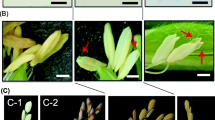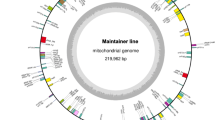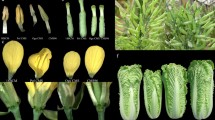Abstract
We reported earlier an evolutionarily conserved mitochondrial orf108 causing cytoplasmic male sterility (CMS) in four alloplasmic lines of Brassica juncea. B. oxyrrhina also carries orf108, but male sterility of B. oxyrrhina-based B. juncea CMS lines is not restored by the Moricandia arvensis restorer that rescues other orf108-containing B. juncea CMS lines. To understand this discrepancy, we characterized B. oxyrrhina-based B. juncea CMS line (oxy-cms) to identify the mitochondrial gene associated with male sterility. Examination of expression patterns of 26 mitochondrial genes in CMS and male fertile (oxy-camp, i.e. amphidiploid B. oxyrrhina × B. rapa, and euplasmic B. juncea) lines revealed polymorphic transcript patterns for six genes: atp1, atp4, ccmfn2, cox3, nad4L and orf108. Detailed analysis showed that orf108 is linked and co-transcribed with atp1. Comparison of orf108-atp1 transcripts in male sterile and male fertile flowers revealed that B. oxyrrhina restorer cleaves orf108-atp1 at a different location within the orf108 coding region as compared with the M. arvensis restorer. A total of eleven SNPs were detected within the orf108 coding region. One of these SNPs was located at the site where M. arvensis restorer processes the orf108-atp1 transcript suggesting that it could be critical for cleavage of orf108-atp1 transcript by the M. arvensis restorer.





Similar content being viewed by others
References
Abad AR, Mehrtens BJ, Mackenzie SA (1995) Specific expression in reproductive tissues and fate of a mitochondrial sterility-associated protein in cytoplasmic male-sterile bean. Plant Cell 7:271–285
Arrieta-Montiel M, Lyznik A, Woloszynska M, Janska H, Tohme J, Mackenzie S (2001) Tracing evolutionary and developmental implications of mitochondrial stoichiometric shifting in the common bean. Genetics 158:851–864
Ashutosh, Kumar P, Sharma PC, Prakash S, Bhat SR (2008) A novel orf108 co-transcribed with atpA gene is associated with cytoplasm male sterility in Brassica juncea carrying Moricandia arvensis cytoplasm. Plant Cell Physiol 49:284–289. doi:10.1093/pcp/pcm182
Budar F, Touzet P, Paepe RD (2003) The nucleo-mitochondrial conflict in cytoplasmic male sterilities revisited. Genetica 117:3–16
Chen L, Liu YG (2014) Male sterility and fertility restoration in crops. Annu Rev Plant Biol 65:579–606. doi:10.1146/annurev-arplant-050213-040119
Dill CL, Wise RP, Schnable PS (1997) Rf8 and Rf ∗ mediate unique T-urf13-transcript accumulation, revealing a conserved motif associated with RNA processing and restoration of pollen fertility in T-cytoplasm maize. Genetics 147:1367–1379
Forner J, Weber B, Thuss S, Wildum S, Binder S (2007) Mapping of mitochondrial mRNA termini in Arabidopsis thaliana: t-elements contribute to 5′ and 3′ end formation. Nucleic Acids Res 35:3676–3692
Fujii K, Toriyama S (2008) Genome barriers between nuclei and mitochondria exemplified by cytoplasmic male sterility. Plant Cell Physiol 49:1484–1494
Gobron N, Waszczak C, Simon M, Hiard S, Biovin S, Charif D, Ducamp A, Wenes E, Budar F (2013) A cryptic cytoplasmic male sterility unveils a possible gynodioecious past for Arabidopsis thaliana. PLoS ONE 8(4):e62450. doi:10.1371/journal.pone.0062450
Gray MW, Hanic-Joyce PJ, Covello PS (1992) Transcription, processing and editing in plant mitochondria. Annu Rev Plant Physiol Plant Mol Biol 43:145–175
Grelon M, Budar F, Bonhomme S, Pelletier G (1994) Ogura cytoplasmic male-sterility (CMS)-associated orf138 is translated into a mitochondrial membrane polypeptide in male sterile Brassica cybrids. Mol Gen Genet 243:540–547
Iwabuchi M, Koizuka N, Fujimoto H, Sakai T, Imamura J (1999) Identification and expression of the Kosena radish (Raphanus sativus cv. Kosena) homologue of the ogura radish CMS-associated gene, orf138. Plant Mol Biol 39:183–188
Kirti PB, Narasimhulu SB, Mohapatra T, Prakash S, Chopra VL (1993) Correction of chlorophyll deficiency in alloplasmic male sterile Brassica juncea through recombination between chloroplast genomes. Genet Res Camb 62:11–14
Kirti PB, Mohapatra T, Khanna H, Prakash S, Chopra VL (1995) Diplotaxis catholica + Brassica juncea somatic hybrids: molecular and cytogenetic characterization. Plant Cell Rep 14:593–597
Kohler RH, Horn R, Lossl A, Zetsche K (1991) Cytoplasmic male sterility in sunflower is correlated with the co-transcription of a new open reading frame with the atpA gene. Mol Gen Genet 227:369–376
Kruft V, Eubel H, Jänsch L, Werhahn W, Braun H (2001) Proteomic approach to identify novel mitochondrial proteins in Arabidopsis. Plant Physiol 127:1694–1710. doi:10.1104/pp.010474
Kubo T, Kitazaki K, Matsunaga M, Kagami H, Mikami T (2011) Male sterility-inducing mitochondrial genomes: how do they differ? Crit Rev Plant Sci 30:378–400. doi:10.1080/07352689.2011.587727
Kumar P, Vasupalli N, Srinivasan R, Bhat SR (2012) An evolutionarily conserved mitochondrial orf108 is associated with cytoplasmic male sterility in different alloplasmic lines of Brassica juncea and induces male sterility in transgenic Arabidopsis thaliana. J Exp Bot 63:2921–2932. doi:10.1093/jxb/err459
L’Homme Y, Stahl RJ, Li X, Hameed A, Brown GG (1997) Brassica nap cytoplasmic male sterility is associated with expression of a mtDNA region containing a chimeric gene similar to the pol CMS associated orf224 gene. Curr Genet 31:325–335
Luo D, Xu H, Liu Z, Guo J, Li H, Chen L, Fang C, Zhang Q, Bai M, Yao N, Wu H, Wu H, Ji C, Zheng H, Chen Y, Ye S, Li X, Zhao X, Li R, Liu YG (2013) A detrimental mitochondrial–nuclear interaction causes cytoplasmic male sterility in rice. Nat Genet 45:573–577. doi:10.1038/ng.2570
Prakash S, Chopra VL (1988) Synthesis of alloplasmic Brassica campestris as a new source of cytoplasmic male sterility. Plant Breed 101:253–255
Prakash S, Chopra VL (1990) Male sterility caused by cytoplasm of Brassica oxyrrhina in B. campestris and B. juncea. Theor Appl Genet 79:285–287
Sambrook J, Fritsch EF, Maniatis T (1989) Molecular cloning: a laboratory manual, 2nd edn. Cold Spring Harbor Laboratory Press, New York
Singh M, Brown GG (1991) Suppression of cytoplasmic male sterility by nuclear genes alters expression of a novel mitochondrial gene region. Plant Cell 3:1349–1362
Wang Z, Zou Y, Li X, Zhang Q, Chen L, Wu H, Su D, Chen Y, Guo J, Luo D, Long Y, Zhong Y, Liu Y-G (2006) Cytoplasmic male sterility of rice with Boro II cytoplasm is caused by a cytotoxic peptide and is reversed by two related PPR motif genes via distinct modes of mRNA silencing. Plant Cell 18:676–687
Yamagishi H, Bhat SR (2014) Cytoplasmic male sterility in Brassiceae. Breed Sci 64:38–47. doi:10.1270/jsbbs.64.38
Author contribution
VN conducted most of the experiments; SKS and VK assisted in transcript mapping; AW assisted in preparation of Southern blots; SRB generated the materials; SRB, KRSS and PK planned the experiment; SRB, VN and PK wrote the manuscript.
Author information
Authors and Affiliations
Corresponding author
Ethics declarations
Conflict of interest
The authors declare that they have no conflict of interest.
Electronic supplementary material
Below is the link to the electronic supplementary material.
Suppl. Fig. 1
Alignment of protein sequences of atp1 of B. oxyrrhina and M. arvensis. Identical alignments are boxed. Upward arrow indicates the amino acids have same physicochemical properties (JPEG 123 kb)
Suppl. Fig. 2
Alignment of ORF108 of B. oxyrrhina and M. arvensis. Identical alignments are boxed (JPEG 26 kb)
Suppl. Fig. 3
Verification of co-transcription of atp4 and nad4L in B. juncea (1), oxy-cms (2) and oxy-camp (3). Gel photograph of amplicons obtained after RT-PCR and PCR with the primers atp4 F and nad4L R. Amplicon size is indicated in kb (JPEG 9 kb)
Rights and permissions
About this article
Cite this article
Naresh, V., Singh, S.K., Watts, A. et al. Mutations in the mitochondrial orf108 render Moricandia arvensis restorer ineffective in restoring male fertility to Brassica oxyrrhina-based cytoplasmic male sterile line of B. juncea . Mol Breeding 36, 67 (2016). https://doi.org/10.1007/s11032-016-0489-4
Received:
Accepted:
Published:
DOI: https://doi.org/10.1007/s11032-016-0489-4




